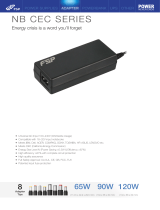
9
Unplug from
power outlet
Unplug from
power outlet
Caution
• Do not use or store the Cradle in/
on an unstable place, such as a
television set, etc. If it falls, it may
cause injury or break.
• Unplug the AC adapter or power
cord from the cradle and AC outlet
when not using for extended
periods of time. If this precaution
is not followed and the cradle is
damaged then fire may occur.
AC Adapter
Danger
• Be sure to use the AC Adapter with
the proper voltage (AC 100 - 240 V).
Using it with other voltage levels
may cause fire, explosion,
overheating, electric shock or
injury.
• For safety, be sure to unplug the
AC Adapter from the outlet before
performing maintenance or
cleaning. Also, never plug in or
disconnect the power plug with a
wet hand. This may cause electric
shock or injury.
Warning
•Do not attempt to disassemble, repair or
modify the AC adapter in any way.
• Keep foreign objects including water, metal,
or flammable substances from getting inside
the product.
• Do not moisten the AC adapter or touch it
with a wet hand.
• Do not use the AC adapter in the vicinity of
flammable gas (including gasoline, benzine
and lacquer thinner).
General Precautions
In case
• ... the internal parts of the AC adapter are
exposed because it has been dropped or
otherwise damaged:
• ... the AC adapter is dropped in water, or if
water, metal flammable substances or other
foreign objects get inside it:
• ... you notice anything unusual when using
the AC adapter such as abnormal noise, heat,
smoke, or a burning odour:
1 do not touch any of the exposed parts;
2 immediately disconnect the power supply
plug from the power outlet, and;
3
call your dealer or local Olympus representative
for servicing. Continued use of the AC adapter
under these circumstances could result in
electric shock, fire or injury.
Caution
• Do not use the AC Adapter if the
power plug is damaged or the plug
is not completely connected to the
outlet. This may cause fire,
overheating, electric shock, short
circuit or damage.
• Unplug the AC Adapter from AC outlet
when not using. If this precaution is
not followed, fire, overheating or
electric shock may occur.
• Make sure to hold the plug when
removing the power plug from the
outlet. Do not bend the cord
excessively or put a heavy object on
it. This may cause fire, overheating,
electric shock or damage.
Unplug from
power outlet




















